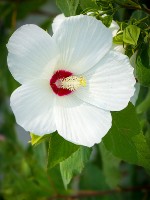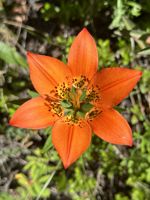Mon-Fri 9am - 5pm Mountain time
Swamp Rose Mallow (Hibiscus) vs Wood Lily
Hibiscus moscheutos
Lilium philadelphicum
NOT AVAILABLE THIS SEASON - MIGHT RETURN
CUSTOM GROW
Swamp Rose Mallow (Hibiscus) has large white-pink showy flowers which attract hummingbirds and pollinators to your yard. It is a tall, fast growing perennial shrub. The flowers typically only last 1-2 days, but the plant will continue to rebloom throughout the season.
This hibiscus tolerates heat and humidity but does not do well when exposed to wind. Make sure the plant has access to lots of moisture for better flowering.
The Swamp Rose Mallow (Hibiscus) is also known as the dinner plate hibiscus because it can grow incredibly large flowers, as big as dinner plates.
Wood Lily is a native perennial wildflower known for its vibrant, trumpet-shaped blooms in shades of orange to red. Its showy flowers appear mid-summer and are highly visible in meadows and prairies. The upward-facing flowers are an important nectar source for many pollinators, including native bees, butterflies, and hummingbirds.
Unlike most lilies, the Wood Lily’s flowers face upward rather than nodding. It is slow to establish and may take years before flowering, but once mature, it requires little maintenance. It is well-suited for pollinator gardens, naturalisation projects, prairie restoration, and open woodland plantings.
Wood Lily is the provincial flower of Saskatchewan and North America’s most widespread lily. Despite its wide natural range, populations have been declining. Habitat loss, overgrazing by deer, and unsustainable picking have reduced both its abundance and density across many regions. These pressures highlight the importance of protecting and restoring this once-common wildflower.
Swamp Rose Mallow (Hibiscus) Quick Facts
Wood Lily Quick Facts
Toxicity: toxic to cats

